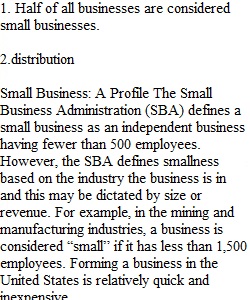


Q Small Business: A Profile The Small Business Administration (SBA) defines a small business as an independent business having fewer than 500 employees. However, the SBA defines smallness based on the industry the business is in and this may be dictated by size or revenue. For example, in the mining and manufacturing industries, a business is considered “small” if it has less than 1,500 employees. Forming a business in the United States is relatively quick and inexpensive. The United States has more than 31 million businesses and more than 99 percent of those are considered small businesses. As you can imagine, small businesses are vital to the U.S. economy. Small businesses: • Employ about half of all private sector employees • Have generated 65 percent of net new jobs over the past 20 years • Made up 97.7 percent of all identified exporters Providing Technical Innovation Small businesses are often great innovators. Many small businesses are credited with major technological advances and inventions such as air conditioning, helicopters, and personal computers—just to name a few. Providing Employment Small businesses add many new jobs to the economy. They often have a larger proportion of younger workers, older workers, women, or workers who prefer to work part time. Additionally, small businesses provided more than 60 percent of new workers with their first jobs and initial training in basic skills. Providing Competition Small businesses often push their larger competitors to become more efficient and responsive to consumer needs. While a small, family-owned convenience store may not be able to compete at all levels with larger chain stores, each small firm competing in its own area and in its own way, together have a competitive effect on the larger stores. Filling the Needs of Society and Other Businesses Small firms provide goods and services not only to consumers but also to each other and to larger firms. It can be less expensive for large firms to buy parts and assemblies from smaller firms rather than manufacturing the parts themselves. Industries That Attract Small Businesses Industries that require a lower initial investment and some special skills or knowledge tend to attract new businesses. Businesses generally fall into three categories of industry: distribution, service, and production: 1. Distribution industries: Includes retailing, wholesaling, transportation, and communication. These account for about 33 percent of all small businesses. 2. Service industries: Includes medical and dental care, repairs, haircutting, restaurant meals, and dry cleaning. These types of businesses account for almost half of all small businesses. 3. Production industries: Includes construction, mining, and manufacturing. About 19 percent of all small businesses are in this industry. The People in Small Businesses: The Entrepreneurs Recall from an earlier chapter that entrepreneurs are people who risk their time, effort, and money to start and operate a business. Entrepreneurship may not be for everyone. Experts suggest there are several characteristics that are specific to entrepreneurs. Entrepreneurial spirit is the desire to create a new business. Some people have a great idea and love the challenge of making a business out of it. Other factors that influence entrepreneurs include independence, a desire to determine one’s own destiny, and the willingness to find and accept a challenge. Often entrepreneurs’ families have a history of starting businesses and age is also a factor—with most people starting their own business between the ages of 24 and 44. Women as Small-Business Owners Women entrepreneurs own 42 percent of all businesses in the United States. Women of color own half of those businesses. Often women start their own businesses to provide flexibility in their family lives or they simply recognized a need and capitalized on the opportunity. Teenagers as Small-Business Owners Entrepreneurship among teenagers is growing. Teens may face difficulties balancing schoolwork and a social life with starting a business. Additionally, those under the age of 18 may face legal issues starting a business or securing financing. Immigrants as Entrepreneurs The Small Business Association (SBA) estimates that one out of every six U.S. businesses with employees is owned by an immigrant. And more than half of U.S. startups that became billion-dollar companies have an immigrant founder or top executive. 1.Which of the following is not true about small businesses in the United States? 2.About 33 percent of all small businesses fall into the _______ category of industry. 3.Small businesses fill the needs of society and other businesses by _______. 4.Which of the following are personality traits that research suggests are specific to entrepreneurs? (Select three.)
View Related Questions